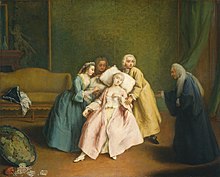
Back إغماء Arabic Bayılma AZ باییلما AZB Kepesan BDR Sinkopa BS Síncope (medicina) Catalan Synkopa (medicína) Czech Llesmair CY Besvimelse Danish Synkope (Medizin) German
| Syncope | |
|---|---|
| Other names | Fainting, blacking out, passing out, swooning |
 | |
| A 1744 oil painting by Pietro Longhi called Fainting | |
| Specialty | Neurology, cardiology |
| Symptoms | Loss of consciousness and muscle strength[1] |
| Complications | Injury[1] |
| Usual onset | Fast onset[1] |
| Duration | Short duration[1] |
| Types | Cardiac, reflex, orthostatic hypotension[1] |
| Causes | Decrease in blood flow to brain[1] |
| Diagnostic method | Medical history, physical examination, electrocardiogram[1] |
| Treatment | Based on underlying cause[2] |
| Prognosis | Depends on underlying cause[2] |
| Frequency | ~5 per 1,000 per year[1] |
Syncope ((ⓘ), commonly known as fainting or passing out, is a loss of consciousness and muscle strength characterized by a fast onset, short duration, and spontaneous recovery.[1] It is caused by a decrease in blood flow to the brain, typically from low blood pressure.[1] There are sometimes symptoms before the loss of consciousness such as lightheadedness, sweating, pale skin, blurred vision, nausea, vomiting, or feeling warm.[3][1] Syncope may also be associated with a short episode of muscle twitching.[1][3] Psychiatric causes can also be determined when a patient experiences fear, anxiety, or panic; particularly before a stressful event, usually medical in nature.[4][5] When consciousness and muscle strength are not completely lost, it is called presyncope.[1] It is recommended that presyncope be treated the same as syncope.[1]
Causes range from non-serious to potentially fatal.[1] There are three broad categories of causes: heart or blood vessel related; reflex, also known as neurally mediated; and orthostatic hypotension.[1][3] Issues with the heart and blood vessels are the cause in about 10% and typically the most serious while neurally mediated is the most common.[1] Heart related causes may include an abnormal heart rhythm, problems with the heart valves or heart muscle and blockages of blood vessels from a pulmonary embolism or aortic dissection among others.[1] Neurally mediated syncope occurs when blood vessels expand and heart rate decreases inappropriately.[1] This may occur from either a triggering event such as exposure to blood, pain, strong feelings or a specific activity such as urination, vomiting, or coughing.[1] Neurally mediated syncope may also occur when an area in the neck known as the carotid sinus is pressed.[1] The third type of syncope is due to a drop in blood pressure when changing position such as when standing up.[1] This is often due to medications that a person is taking but may also be related to dehydration, significant bleeding or infection.[1] There also seems to be a genetic component to syncope.[6]
A medical history, physical examination, and electrocardiogram (ECG) are the most effective ways to determine the underlying cause.[1] The ECG is useful to detect an abnormal heart rhythm, poor blood flow to the heart muscle and other electrical issues, such as long QT syndrome and Brugada syndrome.[1] Heart related causes also often have little history of a prodrome.[1] Low blood pressure and a fast heart rate after the event may indicate blood loss or dehydration, while low blood oxygen levels may be seen following the event in those with pulmonary embolism.[1] More specific tests such as implantable loop recorders, tilt table testing or carotid sinus massage may be useful in uncertain cases.[1] Computed tomography (CT) is generally not required unless specific concerns are present.[1] Other causes of similar symptoms that should be considered include seizure, stroke, concussion, low blood oxygen, low blood sugar, drug intoxication and some psychiatric disorders among others.[1] Treatment depends on the underlying cause.[1][3] Those who are considered at high risk following investigation may be admitted to hospital for further monitoring of the heart.[1]
Syncope affects about three to six out of every thousand people each year.[1] It is more common in older people and females.[7] It is the reason for one to three percent of visits to emergency departments and admissions to hospital.[7] Up to half of women over the age of 80 and a third of medical students describe at least one event at some point in their lives.[7] Of those presenting with syncope to an emergency department, about 4% died in the next 30 days.[1] The risk of a poor outcome, however, depends very much on the underlying cause.[2]
- ^ a b c d e f g h i j k l m n o p q r s t u v w x y z aa ab ac ad ae af ag ah Peeters SY, Hoek AE, Mollink SM, Huff JS (April 2014). "Syncope: risk stratification and clinical decision making". Emergency Medicine Practice. 16 (4): 1–22, quiz 22–23. PMID 25105200.
- ^ a b c Ruwald MH (August 2013). "Epidemiological studies on syncope – a register based approach". Danish Medical Journal. 60 (8): B4702. PMID 24063058.
- ^ a b c d Cite error: The named reference
NIH2020was invoked but never defined (see the help page). - ^ Chen-Scarabelli C, Scarabelli TM (2004). "Neurocardiogenic syncope". British Medical Journal. 329 (329): 336–341. doi:10.1136/bmj.329.7461.336. PMC 506859. PMID 15297344.
- ^ Singh JR, Rand EB, Erosa SC, Cho RS, Sein M (2021). "Aromatherapy for Procedural Anxiety in Pain Management and Interventional Spine Procedures: A Randomized Trial". American Journal of Physical Medical Rehabilitation. 100 (10): 978–982. doi:10.1097/PHM.0000000000001690. PMID 33443859.
- ^ Hadji-Turdeghal K (2019). "Genome-wide association study identifies locus at chromosome 2q32. 1 associated with syncope and collapse". Cardiovascular Research. 116: 138–148. doi:10.1093/cvr/cvz106. PMC 6918066. PMID 31049583.
- ^ a b c Kenny RA, Bhangu J, King-Kallimanis BL (2013). "Epidemiology of syncope/collapse in younger and older Western patient populations". Progress in Cardiovascular Diseases. 55 (4): 357–363. doi:10.1016/j.pcad.2012.11.006. hdl:2262/72984. PMID 23472771.